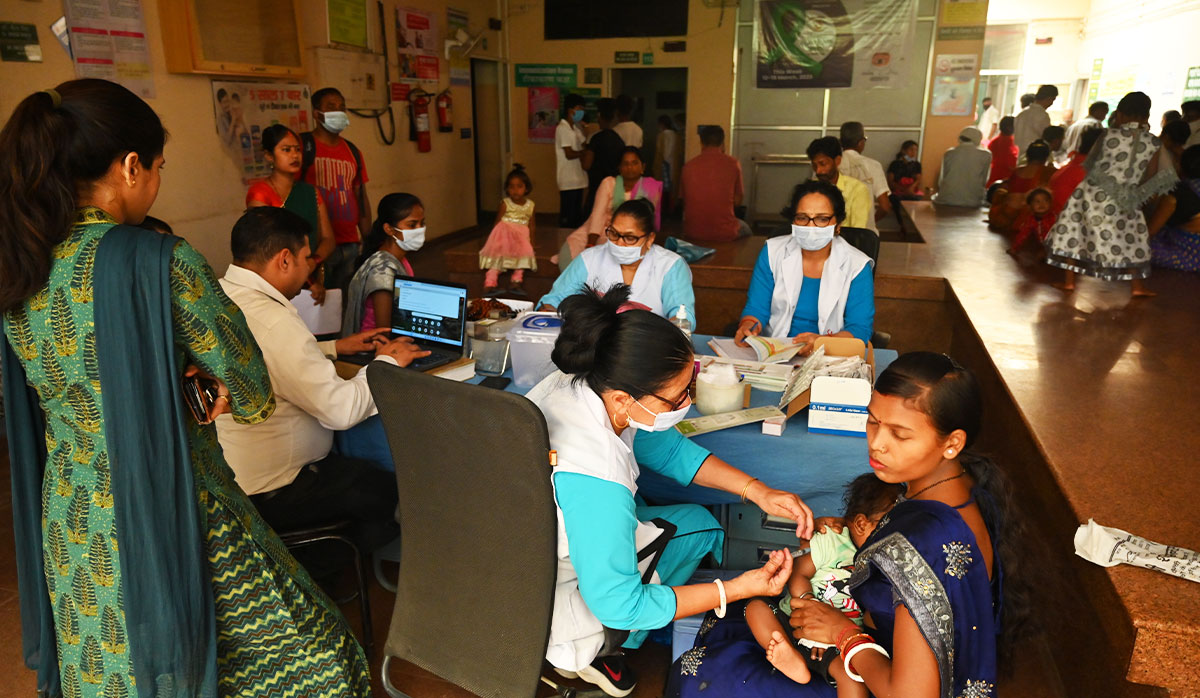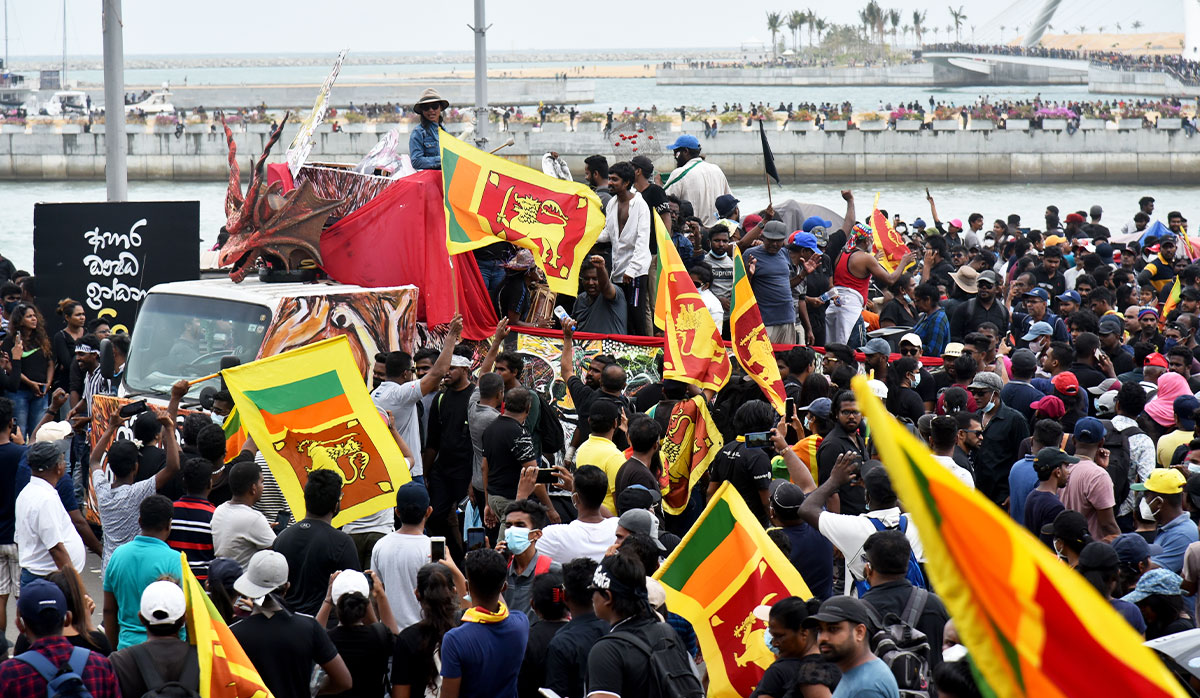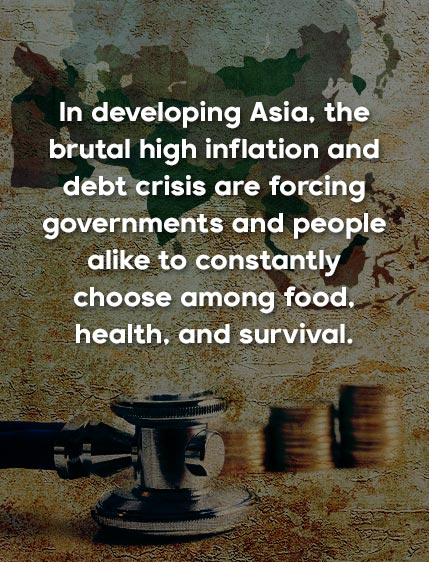|
Getting your Trinity Audio player ready...
|
At a glance
- Asian governments increased healthcare spending over the past two years but the reverse is now the trend in countries where it’s needed most.
- New austerity measures and realigned aid are increasing pressures on the region’s people, especially in South Asia.
- Setbacks in implementing universal healthcare will hit harder as the pandemic continues and inflation weighs heavily on poor households.
T
his March, the assembly government of the largest state in the world’s most populous country passed landmark legislation on healthcare. But far from being met with cheers, Rajasthan’s Right to Health Bill, now a law covering 80 million, had to endure sustained protests by doctors and other healthcare professionals, who for two weeks poured into the streets of the northern Indian state.
The law guarantees free “access to quality health care,” including emergency services in “select private institutions,” to all Rajasthan residents. Its critics call it “draconian,” adding that it is too vague on reimbursement procedures and shifts the responsibility to private hospitals and doctors.
Activists and healthcare policymakers have since said the law is a “step in the right direction” as it expands access to healthcare, particularly for Rajasthan’s 22 million poor people. But the question raised by the protests highlights a critical issue haunting Asian healthcare systems: Who’s footing the bill?
That question is now being put to the test, particularly in Southeast Asia and India, which are experiencing a resurgence of COVID-19 cases and deaths — in huge contrast to waning numbers in the majority of countries. But as Asia’s poorest people are once again forced to confront the pandemic head-on, this time they must do so while also dealing with unprecedented food price spikes and the worst economy in decades.
Whether they’ll be able to survive unscathed will be determined by their own governments’ priorities. As a report published by the global task force on COVID-19 policies set up by the G20 in 2021 points out, “It is within our means to avoid repeating the large-scale collective failures that led to the damaging pandemic.”

Record spending on healthcare
For sure, the past three years have seen the single biggest boost in funding to healthcare systems, investments in robust disease-surveillance capabilities, and attempts at expanding access to critical medical care for the majority of Asians. In 2020, global aid for health in Asia increased by 48.5 percent — a huge leap after decades of plateauing commitments. The next year, nearly half of the US$37.8 billion in global aid for health went to the region as deaths skyrocketed, especially in South Asia.
Driving better healthcare through loans (2021)
Graph 1: Official development assistance from Japan and loans from the World Bank contributed the most to upgrading healthcare systems in Asia.
(Source: International Health Metrics and Evaluation)
Huge sums of aid from Japan and other rich countries went toward supporting vaccination drives and COVID-19 detection systems in developing Asia. A mix of vaccine donations, grants, and loans amounted to over US$17 billion, of which two-thirds, or US$11.5 billion, went to India, Pakistan, Bangladesh, Indonesia, Myanmar, and the Philippines alone.
But external aid, however crucial, can only go so far. In fact, only Bhutan, Papua New Guinea, Lao PDR, and Nepal relied on aid and loans for more than 10 percent of their healthcare spending in 2021. The vast majority of countries ramped up government spending — at levels not seen pre-pandemic — to mount COVID-19 containment strategies, including vaccination, raising hospital bed capacities, and investing in disease surveillance.
Wealthy nations have spent billions of dollars upgrading hospitals and improving healthcare systems since the pandemic began. In Japan, this peaked at about US$4,665 per citizen in 2021. China and Singapore also saw huge upticks in government investments in hospitals, medical surveillance, and vaccination drives.
Underfunded healthcare
Graph 2: Only Japan and South Korea reached 5% of the GDP target in healthcare spending by 2021.
(Source: Global Health Expenditure Database)
Governments in developing Asia also spent more in 2020 and 2021, with an average increase of 0.3 percent of GDP. That, however, is nowhere near the average 5 percent increase in OECD (Organisation for Economic Co-operation and Development) countries or even the minimum recommendation by the World Health Organization of at least a 1 percent increase annually over the next five years.
The U.N. has suggested that governments capitalize on the pandemic-induced momentum, however modest, to accelerate gains in providing healthcare for all, especially for developing countries in Asia. But 2022 proved to be a disastrous year for inflation in most of Asia. The think tank Center for Global Development warns that at least 104 countries either cannot afford to increase spending or may spend less on health in the next five years due to inflation, debt, and recession risks. India already cut healthcare spending to 1.19 percent of GDP from 1.23 percent last year, and is expected to further slash it to 1.17 percent next year.
Diverging recoveries and stagnation in the next three years
Graph 3: The World Bank projects that diverging recoveries will widen the already yawning gap between rich and poor nations.
(Source: World Bank)
Compounding crises, co-morbidities
Since last year, the massive mountain of debt accumulated before and after COVID spending has been growing faster due to high food and fuel inflation and devaluing currencies.
A canary in the coal mine, Sri Lanka’s economy imploded in early March 2022, leaving its people floundering under two-digit inflation rates (now at 50.6 percent). High inflation across Asia also meant costlier medicine and life-saving equipment. In the island country, where over 85 percent of the medicine supply comes from overseas, a cardiac medicine bought previously for around US$2 now costs at least US$14 in local pharmacies.
In India, shortages in rural healthcare facilities are now more evident despite the gargantuan budget and loans for healthcare-system upgrades in the last three years.
Healthcare inaccessibility in rural India
Map 1: Map showing rural facilities per 100,000 people in rural India.
(Source: Indian Ministry of Rural Development)
Even pre-pandemic, reports suggest that primary healthcare centers (PHCs) and community health centers in rural India had an average of fewer than one doctor. Recent government data, however, suggest that at least three out of 10 PHCs have no doctor this year. But because the cost of hospitalization is six times higher in private hospitals than in public ones in India, the majority of rural Indians rely on the few bedded public facilities available in each state.
India's overreliance on primary health centers and community centers
Graph 4: In India, only Kerala and West Bengal have more than 25% of their facilities as bed hospitals.
(Source: Indian Ministry of Rural Development)
Drying up aid, austerity budgets
Inflation is squeezing not just the governments of poor countries. Aid for health is also expected to be reduced in the next few years. Already, WHO’s newly launched Pandemic Preparedness Fund received only US$400 million in aid, well below the US$10 billion it said it needed. The World Bank’s concessional financing window, a major healthcare-funding channel, has also been halved this year.
Aid for health might have already peaked in 2020, as subsequent ODA — while higher — realigned to COVID-19 some of the budget supposedly earmarked for basic healthcare facilities and access. The last two years have seen a decline in funding for maternal health and malaria prevention in favor of funding the COVID-19 response.
Realigned aid priorities in 2022
Graph 5: Realigned aid priorities in 2022 reveal a decline in malaria and maternal health funding in favor of assistance relating to COVID-19 and other infectious diseases.
(Source: Institute for Health Metrics and Evaluation)
Too, in the name of “sound fiscal policy,” the likes of the International Monetary Fund (IMF) are encouraging austerity in debt- distressed nations. Sri Lanka’s new government is ending universal free healthcare and introducing privatized schemes as part of the IMF bailout deal. This signals the fall of the last bastion of accessible healthcare in South Asia. Previously, over half of all medical care, 95 percent of hospitalizations, and 99 percent of all preventive care in Sri Lanka were provided by the public health system.
A similar rollback in public spending is expected in at least 20 countries in Asia and the Pacific, says a recent report by the European Network on Debt and Development (Eurodad). The majority of governments will implement austerity measures that reduce spending on areas like public services and healthcare for the vulnerable, it also says.
Universal healthcare for some?
In developing Asia, the brutal high inflation and debt crisis are forcing governments and people alike to constantly choose among food, health, and survival.
In truth, despite the extraordinary push in government spending and aid due to the pandemic, the region has little to nothing to show for in terms of expanding universal healthcare coverage.
Universal healthcare coverage in Asia
Map 2: Universal healthcare in 12 countries in Asia is still below 70% despite pandemic spending in 2022.
(Source: UN Statistics)
Even before the pandemic, roughly 1.6 billion people in Asia had no access to social protection and were thus especially vulnerable to such shocks. And depending on their national policies, uninsured patients shoulder the cost of medicine, treatments, and hospital visits out-of-pocket.
Out-of-pocket spending is a portion of a healthcare system’s bill that is borne by the patients themselves. Slow but steady reduction of this burden could be seen in some countries until 2019, but the last two years wiped out or even reversed some of these gains.
How COVID-19 erased progress in healthcare accessibility in Asia
Graph 6: The graph measures changes in out-of-pocket spending between 2015-2019 and 2020-2022. At least eight countries in Asia have regressed in making healthcare affordable, while six others have shown progress.
(Source: UN Statistics)
Official estimates show that in at least six countries in developing Asia, people have had to shell out more for medical attention and services since 2022. The two worst performers, Vietnam and Myanmar, are now charging their citizens 30 cents more per dollar for using health facilities and pharmaceutical supplies than in 2020.
In 2022, Vietnam, Thailand, and Malaysia were among the relatively rich Asian countries that had over 70 percent of their people with guaranteed free primary healthcare. In part, Vietnam’s stellar stumble since was prompted by its massive privatization of hospitals and medical industries in the last two years. Vietnam signed a free-trade agreement with the European Union in 2020, reducing tariffs on medical investments by 71 percent. The agreement also facilitated the sale of Vietnamese pharmaceutical companies to foreign private investors. In addition, Vietnam opened up its public hospitals to foreign private investors — raising out-of-pocket spending for citizens.
In Myanmar, 750 health workers were arrested, hospitals raided 140 times, and 56 health workers killed from February 2021 to September 2022 alone. The junta has also bombed and attacked hospitals and medical facilities in ethnic minority regions while military blockades in Karenni and Rakhine states have denied humanitarian and medical workers entry.

Shortage or shortchanged?
Myanmar now has the highest out-of-pocket costs in Asia. Bangladesh and then Cambodia follow right behind it, despite some progress.
A huge part of this problem stems from public hospitals, especially in rural areas, having inadequate numbers of medical professionals. A crucial aspect of universal healthcare is patient access to doctors, nurses, midwives, and other medical professionals. Yet countries such as Lao PDR, Bangladesh, Cambodia, and, to a lesser extent, Indonesia have been dealing with health personnel shortages for decades.
A recent World Health Organization (WHO) report has flagged Bangladesh, Nepal, Pakistan, and Lao PDR as among the 55 countries now under the global median and facing increasingly severe medical-professional shortages. After Africa, Southeast Asia has the biggest shortfall in medical professionals among global regions.
Healthcare staffing shortages in Asia (2021)
Graph 7: Twelve countries in Asia faced medical professional shortages in 2021, and fell below the recommended 45 doctors, nurses, and midwives per 10,000 people in the same year.
(Source: World Health Organization)
Among the 17 countries with the available comparable data, only Malaysia, China, North Korea (DPRK), and Japan have enough doctors.
In Bangladesh, rural doctors are paid more than their urban colleagues, but are more likely to be absent from their posts for as many as three-quarters of the calendar year. A recent study suggests that this may be due to insecure working conditions, a lack of financial incentives, and a high patient load.

In Cambodia, the problems are more clear-cut: public hospital doctors are paid less than private hospital doctors, forcing some to moonlight at private facilities.
Worse, in countries like the Philippines and India, nurses are trained specifically for work abroad. As many as 12,000 Filipino nurses leave their country annually, lured by offers of higher salaries and better working conditions in rich Western nations.
With the pandemic now on its third year, the ability of Asian governments to reach and sustain adequate healthcare spending is becoming a marker of divergent recoveries. All the while, a perfect storm of rising inflation, devaluing currencies, and geopolitical tensions is emptying coffers and threatening worse outcomes for the most vulnerable people in the region. ◉



















